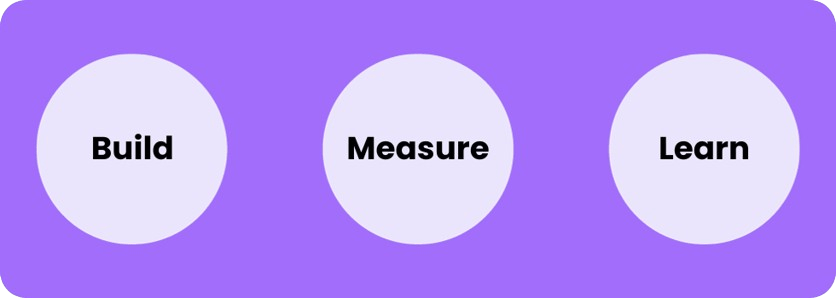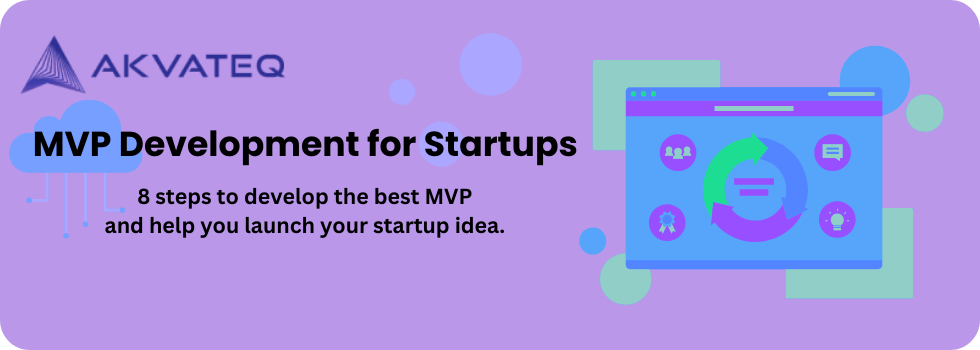In the ever-evolving landscape of startups, a smart strategy that’s becoming popular is using something called a Minimum Viable Product (MVP). This means showing an early version of the final product with only the most important features. This is like a trial or basic version with the most important features for the early customers. It’s a smart way to test a ready product without spending too much time on development. In this guide, we will discuss the steps of MVP development for startups.
On Average, it takes about 4 to 6 months to develop an MVP, but the costs can vary. To make this process faster and more cost-effective. It’s important to hire the right development team.
We’ll guide you through 8 steps to develop the best MVP and help you launch your startup idea.
get in touch to discuss your project
Understanding MVP Development for Startups
MVP software development is a simple version of a software product, which is called a Minimum Viable Product (MVP) in the software industry. This product has just enough features to be used by early customers. The idea is to build a basic version, release it to the market, and then get feedback from real customers to improve the product.
By doing this, you learn what customers like or don’t like, what works well, and what doesn’t. It’s like testing your startup ideas or IT products directly in the market. That’s why there’s a high demand for this kind of development in startup businesses. It’s a way to learn and improve your product based on real user experiences.
MVP vs Proof of Concept vs Prototype
Let’s break down the difference between MVP, Proof of Concept (PoC), and Prototype. These are important stages in creating a product.
Firstly, the Proof of Concept (PoC) is one of the earliest stages of a product’s life. It is done before any significant expenses on the project assembling the team or even deciding what business to get into. Its purpose is to establish whether or not you can do it and if you should invest in it.
Next is “prototype.” This occurs when the product starts having a more tangible form. It assists in giving the team an overview of what their building would look like. Prototypes may be as simple as drawing on paper while for advanced ones you can use Figma to sketch wireframes of your product.
Now Minimum Viable Product (MVP) comes next. It’s just an elementary version that possesses only those features, without extras, that real customers need. It’s like a tiny working model that helps make better versions.
In summary, from testing basic ideas through visual modeling up to making a simplified model for real people that are needed. Every move taken confirms that the product is on track before plunging into full-scale development. Every move taken confirms that the product is on track before going all-in on development.
Building an MVP Comes With Several Advantages:
The basic idea for MVP is to quickly penetrate the market and gather real user feedback for improvements. If you skip MVP development, the alternative is investing in more software development cycles. Remember modern companies are doing this practice. MVP helps you to understand the market better. It creates initial demand, makes revenue, and learns from the product’s first users for future development.
- You get helpful and useful feedback on the basic features of your product.
- You don’t have to invest in the entire product upfront while saving your time too.
- It encourages learning and improvement during product development.
- It attracts investors who prefer to see a working product rather than hear about business ideas.
- Faster Time-to-Market
- Cost-Effective Development
- A More Robust Building Block for Development
Even if your custom MVP project doesn’t capture all these benefits, grabbing a few can cut down overall development costs. This will speed up your entry into the market. That’s why MVP development is usually a smart move for startups.
Now, the question is, how do you find the right MVP developer or development company for the job? Let’s explore that.
How to do MVP Development for Startups
Determine the problem
Identifying the problem your product solves is crucial. Every product aims to make life easier by addressing a specific issue. For instance, successful companies like Spotify and Google Maps. Spotify helps people to access music, and Google Maps simplifies navigation for commuters.
When creating your MVP, it should tackle either an existing problem or an artificially modeled one.
Existing problem. This means your target users lack a solution. For instance, imagine a world where people struggle to organize their digital notes. You create an app that organizes and syncs notes across devices, addressing this existing problem.
Artificially modeled problem. This means introducing a new way users behave to improve their experience. For instance, the rising trend of fitness enthusiasts looking for interactive workout solutions. If you create an app that combines virtual reality and fitness routines to make exercising more engaging and enjoyable. You are addressing this newly modeled problem.
Solving an artificially-modeled problem usually requires more effort in marketing and functionality. You must communicate your product’s benefits and ensure user-friendliness. The key is creating a useful application, avoiding the fate of startups that fail due to a lack of market demand. Remember, your product should solve a real problem or offer genuine value to succeed.
get in touch to discuss your project
Analyze the Market and Target Audience
The next step is to look at the market, and in this regard, it is necessary to find out about your competitors. Research if any similar products exist there and understand what differentiates your product.
When you have a lot of competition, make sure that you stand out. You can do this by improved design, better functionality, competitive pricing Or meeting user needs more adequately.
At times, success comes from providing a new solution to an existing problem. Competition analysis results demonstrate how important your product is when compared with others in the market.
While concentrating on the main market it would also be wise to consider global ones. This minimizes risks since you could expand later.
Market research is a vital stage in creating a successful MVP (Minimum Viable Product). If you fail to keep pace with current trends in the industry then your ideas might become obsolete or irrelevant. It is also worth noting that no proper survey of markets could lead your innovation to failure. Recent studies indicate that reasons for startup failures are lack of need for their products by 42%, running out of cash at 29% and team incompetence at 23%. By knowing what people want, you can adjust your idea to match what they actually need today.
Remember, running out of money, tough competition, pricing problems, and a lack of resources are common failing reasons. Be mindful of these challenges to increase your chances of success.. It’s essential to be aware of these challenges and plan accordingly.
Determine Value Proposition
When we talk about the value proposition, we’re asking, “What will users get from our product, and why would they want it?”
To figure this out, consider the problem your product solves, how it’s different from what’s already out there, and who your audience is.
For an MVP (Minimum Viable Product), you’re focusing on delivering value in its most basic form. Start by understanding your users and build the MVP based on what they need.
To improve and clarify your value proposition, get your team involved and ask questions like: What problem does our product solve? How is this problem currently solved? How will our product solve this problem better than competitors for customers? Make sure your value proposition is clear and doable for your clients.
Identify a user flow

Creating a user-friendly design is a crucial step in the MVP process. It’s important to think about how users will navigate the app. From starting it to completing actions like making a purchase or receiving a delivery. User flow ensures that every step is clear, nothing is missed, and the final product aligns with the best UX.
Defining user flow involves outlining the stages of the process. Focusing on simple tasks like finding and buying products or managing and receiving orders rather than diving into complex features. These are the goals users aim to achieve. Once you outline these stages, it’s time to specify the features for each step.
Prioritize MVP Features
When building an MVP app. It’s common for startups to face the challenge of including unnecessary features for the initial launch. To address this, it’s essential to prioritize functionality through a process like feature prioritization.
It involves brainstorming all possible features and categorizing them based on their impact on the product’s value. Label features as influencing value, potentially influencing or not influencing value.
Functionality that doesn’t impact the app’s value can be postponed for later updates. For features that create value, consider adding them or finding substitutions. For instance, instead of offering all social networks for authorization. Choose the most popular one among your target audience and leave others.
When developing your Minimum Viable Product (MVP), concentrate on vital features. Opt for the widely used social login (or skip for email/phone). Drop a separate feedback page instead of an email or a pre-filled form. This keeps your MVP lean, efficient, and packed with the essentials for initial user validation.
get in touch to discuss your project
Selecting an MVP development company
After considering your options in the previous steps. Choose an MVP development company or team of developers that suits your needs and budget. It’s crucial to gather input from all involved parties before finalizing your decision. Once you’ve picked an MVP software development company, engage in negotiations and finalize the arrangement by signing a contract.
When talking to the software company, pay attention to things like how long the contract lasts, how much it costs, and when they’ll deliver. This helps make sure you have a clear and satisfying agreement.
It’s Time to Start Building an MVP
After completing the earlier steps, you can now move forward with your selected company to build your MVP and get ready for your launch.
Remember, an MVP is not a lower-quality version of the final product. The aim is to use MVPs as a starting point to deliver a complete product that meets a need in the market and fulfills consumer demands.
‘B.M.L.’ — Build, Measure, Learn

Creating a product follows a process: first, plan what needs to be done, then start building the product. Once the development is done, the product goes through testing. Quality Assurance engineers do the first tests to make the product better, even if it’s not officially released yet. This step is crucial in MVP development for startups.
After launching the first version (MVP), review everything again. Get feedback from clients on the release. This helps the company understand how well the product is accepted and how it compares to other products in the market, based on what clients say. This continuous cycle of making, testing, and learning is called ‘Build, Measure, Learn,’ where improvements are made based on real feedback.
10 Development Mistakes to Avoid While Building an MVP
Avoid These 10 Common Development Mistakes When Building an MVP:
- Feature Overload: Resist the urge to cram too many features into your MVP. Focus on the essentials for a streamlined and effective product.
- Ignoring User Feedback: User input is invaluable. Don’t disregard feedback; it’s a crucial guide for refining your MVP.
- Rushing Development: Take the necessary time for thorough development. Rushing can lead to oversights and compromise the quality of your MVP.
- Neglecting Scalability: Plan for the future. Ensure your MVP has a scalable foundation to accommodate growth without major disruptions.
- Underestimating Testing: Robust testing is vital. Don’t cut corners; comprehensive testing helps catch and fix issues before they escalate.
- Lack of Clear Value Proposition: Ensure your MVP addresses a specific problem and offers genuine value to users. Avoid ambiguity in your product’s purpose.
- Inadequate Market Research: Understand your market. Skipping this step can result in creating a product that doesn’t meet market needs.
- Poor Communication: Maintain clear and consistent communication within your development team. Miscommunication can lead to mistakes and delays.
- Ignoring Competitors: Be aware of what competitors are doing. Ignoring the competitive landscape can leave your MVP at a disadvantage.
- Overlooking Security: Prioritize security measures from the start. Neglecting security can expose your MVP to risks and harm your users’ trust.
Measuring Success After Launching Your MVP: Essential Metrics for Software Professionals
1. Number of Downloads/Signups
The first metric to monitor is the number of downloads or signups your product receives. This KPI reflects the popularity of your MVP. Keep track of this data either through the app marketplace, GA, or using a dedicated analytics tool.
2. Percentage of Active Users
Check user engagement by calculating the percentage of Daily Active Users (DAU) to Monthly Active Users (MAU). This ratio, expressed as a percentage, provides insights into how many users are active and interact with your app regularly. Aim for a 20%+ active user percentage.
3. Percentage of Paying Users
The percentage of paying users is a metric that reveals the portion of users who convert into paying customers after installing your app. Determine this by dividing the total number of users who installed the app on a specific day by the number of unique users who made a payment on that particular day. This percentage helps assess the conversion rate from free users to paying customers.
4. Average Revenue Per User (ARPU)
The Average Revenue Per User (ARPU) is a metric that measures the average amount of revenue generated from each user of your app. To calculate ARPU, you divide the total revenue the app earns by the total number of users. This metric provides insights into the financial performance of your application on a per-user basis.
5. Churn Rate
The churn rate is a metric that indicates the percentage of users who discontinue subscriptions to an app. This metric is particularly relevant for apps with subscription models or recurring payments. To figure out the churn rate, you divide the number of people who stopped using the app at a certain time by the total number of users when that time started. Then, you multiply the answer by 100 to show it as a percentage. A high churn rate may suggest that users are not finding enough value in your app. Monitoring churn rate is crucial for understanding and mitigating user attrition.
6. User Ratings
Ratings and reviews offer valuable insights into customer sentiment. Users provide feedback about their experience through app marketplaces, in person, or by filling out designated forms. Use these ratings to plan improvements to your MVP.
7. Customer Acquisition Cost (CAC)
Customer Acquisition Cost (CAC) is a measure that shows how much it costs to get each new user for your app in a certain time. To find CAC, you add up all the money spent on marketing and development efforts aimed at gaining new users. And then divide this total by the number of users acquired in that defined timeframe.. Then, you divide that total by the number of users you got during that time. CAC is important because it helps you see how well your marketing plans are working and tells you the amount of money needed to get one new user.
8. Customer Lifetime Value (CLV)
Customer Lifetime Value (CLV) is a metric that represents the total expected revenue a single user is likely to generate over the entire duration of their relationship with your app. Unlike Average Revenue Per User (ARPU), which focuses on immediate transactions. CLV considers the long-term value that users bring. It takes into account various revenue streams such as in-app purchases, subscriptions, ad interactions, and referrals.
To calculate CLV, you sum up the revenue generated from a user across all transactions and interactions and factor in any indirect value they might bring, like referring new users to your app. This metric is crucial for understanding the financial impact of retaining customers over time. CLV guiding decisions on user retention strategies and customer engagement initiatives. A higher CLV indicates a more sustainable and profitable user base.
How much does it cost to build an MVP?
The cost of building a Minimum Viable Product (MVP) can cost different amounts depending on a few things. This includes how complicated the product is, what features it has, the technology used, where the development team is, and how skilled they are. Here’s a breakdown of potential costs:
- Development Team:
- Hiring developers, designers, and other essential team members contributes to the cost. Rates vary globally, with higher costs in regions like North America and Western Europe compared to Eastern Europe, Asia, or South America.
- Features and Complexity:
- The more features and complexity your MVP requires, the higher the development costs. Focus on essential features that show your product’s core value to minimize initial expenses.
- Technology Stack:
- The choice of technology (programming languages, frameworks, databases) can influence costs. Some technologies may have higher development costs but offer long-term benefits in terms of scalability and maintenance.
- Design and User Experience:
- Quality design is crucial for user engagement. Investing in a good user interface (UI) and user experience (UX) design adds to the overall cost but enhances the product’s appeal and usability.
- Testing and Quality Assurance:
- Allocating resources for testing and quality assurance helps find and fix problems early in the development process. This ensures a more robust and reliable MVP.
- Infrastructure and Hosting:
- Costs associated with hosting and server infrastructure should be considered. Cloud services like AWS, Azure, or Google Cloud provide scalable solutions but come with associated expenses.
- Iterative Development:
- Adopting an iterative development approach allows for continuous improvement based on user feedback. While this may extend the development timeline, it can lead to a more refined and successful product.
- Market Research and Validation:
- Research what people want and see if potential users like your basic product. It can the cost. But it’s crucial to ensure that your product meets the market’s needs.
To give you a general idea, creating an MVP can cost tens of thousands to a few hundred thousand dollars. It’s a good idea to team up with a development group to decide exactly what your MVP needs. This way, you can figure out the cost by looking at the specific features your project will have.



















